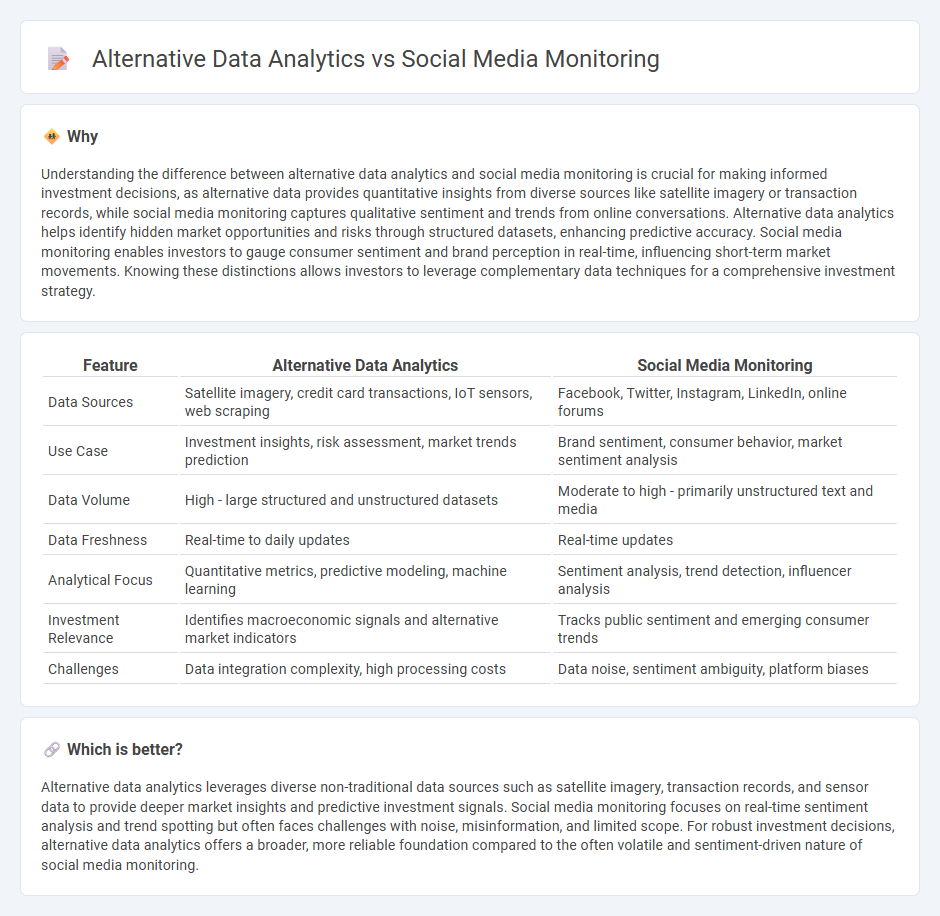
Alternative data analytics leverages unconventional information sources such as satellite images, transaction records, and IoT data to offer unique insights into market trends and company performance. Social media monitoring analyzes real-time user-generated content to gauge public sentiment, brand perception, and emerging consumer behavior patterns. Discover how combining these strategies can enhance investment decisions and portfolio management.
Why it is important
Understanding the difference between alternative data analytics and social media monitoring is crucial for making informed investment decisions, as alternative data provides quantitative insights from diverse sources like satellite imagery or transaction records, while social media monitoring captures qualitative sentiment and trends from online conversations. Alternative data analytics helps identify hidden market opportunities and risks through structured datasets, enhancing predictive accuracy. Social media monitoring enables investors to gauge consumer sentiment and brand perception in real-time, influencing short-term market movements. Knowing these distinctions allows investors to leverage complementary data techniques for a comprehensive investment strategy.
Comparison Table
| Feature | Alternative Data Analytics | Social Media Monitoring |
|---|---|---|
| Data Sources | Satellite imagery, credit card transactions, IoT sensors, web scraping | Facebook, Twitter, Instagram, LinkedIn, online forums |
| Use Case | Investment insights, risk assessment, market trends prediction | Brand sentiment, consumer behavior, market sentiment analysis |
| Data Volume | High - large structured and unstructured datasets | Moderate to high - primarily unstructured text and media |
| Data Freshness | Real-time to daily updates | Real-time updates |
| Analytical Focus | Quantitative metrics, predictive modeling, machine learning | Sentiment analysis, trend detection, influencer analysis |
| Investment Relevance | Identifies macroeconomic signals and alternative market indicators | Tracks public sentiment and emerging consumer trends |
| Challenges | Data integration complexity, high processing costs | Data noise, sentiment ambiguity, platform biases |
Which is better?
Alternative data analytics leverages diverse non-traditional data sources such as satellite imagery, transaction records, and sensor data to provide deeper market insights and predictive investment signals. Social media monitoring focuses on real-time sentiment analysis and trend spotting but often faces challenges with noise, misinformation, and limited scope. For robust investment decisions, alternative data analytics offers a broader, more reliable foundation compared to the often volatile and sentiment-driven nature of social media monitoring.
Connection
Alternative data analytics leverages unconventional datasets such as satellite images, transaction records, and social media feeds to uncover investment insights beyond traditional financial indicators. Social media monitoring provides real-time sentiment analysis, capturing investor mood and market trends that influence asset prices. Integrating social media data into alternative analytics enhances predictive accuracy, enabling more informed and agile investment decisions.
Key Terms
Sentiment Analysis
Social media monitoring captures real-time public sentiment by analyzing posts, comments, and trends across platforms to gauge consumer attitudes and brand perception. Alternative data analytics expands sentiment analysis by incorporating diverse sources such as news articles, financial reports, and satellite imagery, providing a broader and richer context for decision-making. Explore the advantages of combining these approaches to enhance sentiment analysis accuracy and business intelligence.
Data Sources
Social media monitoring primarily relies on real-time user-generated content from platforms like Twitter, Facebook, and Instagram to track trends, sentiments, and brand mentions. Alternative data analytics expands the scope by incorporating diverse datasets such as satellite imagery, financial transactions, web scraping, and sensor data for deeper market insights. Discover how leveraging these distinct data sources can transform your analytics strategy.
Predictive Modeling
Social media monitoring leverages real-time data from platforms like Twitter and Facebook to track trends and sentiment, enhancing predictive modeling accuracy by capturing public behavior patterns. Alternative data analytics integrates unconventional data sources such as satellite imagery, transaction records, and web traffic to enrich predictive models in finance, marketing, and risk management. Explore deeper insights on how combining these data streams can optimize predictive analytics outcomes.
Source and External Links
The Top 23 Social Media Monitoring Tools - Social media monitoring uses software to track, filter, and digest conversations on social media based on keywords, helping businesses identify mentions, analyze sentiment, and respond directly to comments and messages.
Social Media Monitoring: The Complete Guide for 2025 - Social media monitoring is the process of tracking, analyzing, and responding to conversations, mentions, and trends related to a brand, product, or industry across various platforms, offering real-time insight into customer feedback and industry developments.
Social Media Monitoring: A Best Practice and Strategy Guide - Social media monitoring employs digital tools to keep tabs on specific mentions or messages across platforms, with effective tools offering broad coverage, AI-powered analysis, actionable insights, and smart automation for reputation management and rapid response.
 dowidth.com
dowidth.com